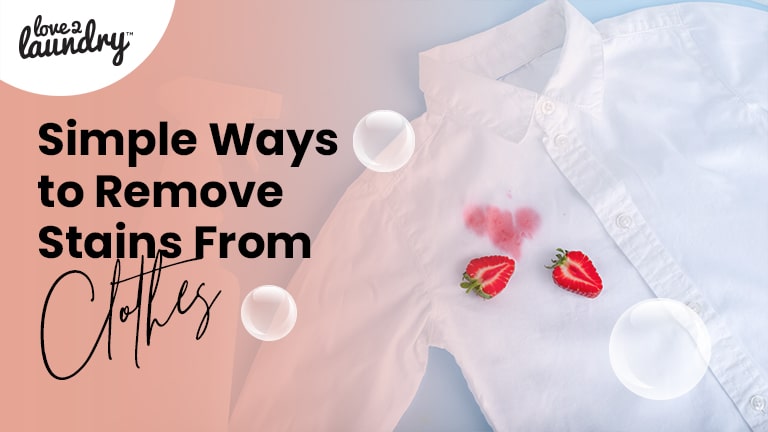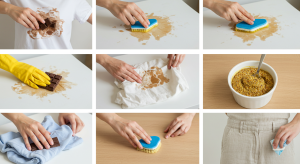
Simple Ways to Remove Stains From Clothes
Stains are the most common stains. Whether it’s a splash of coffee on your favourite shirt or oil on your new jeans, you can permanently remove stains from clothes. With the correct methods and knowledge, you can vanish the stains from your beloved garments.
This blog will show you some simple and effective ways to remove stains from clothes. With this guide by Love2Laundry, tackling stains will be a piece of cake if you take the right actions and act promptly.

General Tips for Stain Removal
There are some simple rules to remove stains from clothes quickly. These few basic rules can make all the difference in saving your clothes:
- Act Fast: Time is crucial when dealing with stains. The longer a stain sits, the harder it becomes. Acting quickly to remove stains will prevent them from deepening into the fabric.
- Test First: Before using any cleaning solution, do a patch test first on any hidden area. This method checks if the solution can cause discolouration or damage, especially to sensitive materials.
- Read Labels: Garment care labels contain essential information about how to clean your clothes safely. They indicate whether the fabric can handle specific treatments, like washing, bleaching, or dry cleaning, helping you avoid accidental damage.
How to Remove Common Stains from Clothes
Multiple common stains—oil, blood, sweat, ink, coffee, tea, red wine, and grease—can ruin your favourite garment if not treated quickly. Apart from these common stains, laundry detergent and colour bleeding stains are also a problem and can ruin your garment instantly. Here’s how you can treat these stains:
- Laundry Detergent Stains from Clothes: Detergent can also leave stains sometimes. You can remove laundry detergent stains from clothes by rinsing the stained area with dilute water, which removes excess detergent residue. Now dab white vinegar on the stain, let it sit for a few minutes, and wash again.
- Remove Colour Bleeding Stains from Clothes: Accidental colour transfer can ruin clothes immediately, but it’s fixable. You can remove colour bleeding stains from clothes by soaking them in oxygen bleach and cold water for 8 hours or overnight.
Bonus Read: Sunscreen stains are also standard, and if not treated quickly, they can ruin your garment. Here’s a blog post on how to remove sunscreen stains from clothes.
How to Remove Ink Stains from Clothes
Ink stains seem like a nightmare because they are challenging to treat and can ruin your garment entirely. Here’s how you can treat them instantly:
- Blot the stain with a paper towel to absorb excess ink.
- Avoid rubbing; it can spread the stain.
- Dab alcohol or hand sanitiser with a cotton and let it sit for 10-15 minutes.
- Rinse the garment under cold water.
- If the stain doesn’t come out with this trick, you must opt for a professional dry clean.
Bonus Read: Does Dry Cleaning Remove Stains? Find out in our blog.
How to Get Rid of Coffee and Tea Stains
Coffee and tea stains are the most common; if not treated quickly, they sit in permanently. Here’s how you can treat them:
- Rinse immediately, and hold the stained area under cold water to flush out the stain.
- Pre-treat with detergent. Apply liquid detergent or a mixture of vinegar and water to the stain and let it sit for 10-15 minutes.
- Now, wash it with warm water following the care instructions.
Step 4: Preparing Your Dress Shirt for Washing
Now comes the next step for the dress shirt dry cleaning, which is the preparation. You can start by inspecting the stain’s condition and choosing washing materials accordingly. Unbutton your dress shirt, as the fabric will sustain damage if the buttons are closed.
Moreover, turn your dress shirts inside out to protect their colour and texture during the wash. This step would be perfect for how to wash shirts.
Removing Grease and Oil Stains
Quick action is needed to remove oil stains from clothes; otherwise, they can sit permanently. Here’s how you can remove oil and black grease stains from clothes:
- To remove the excess, gently blot the black grease or oil stain with a paper towel or cloth.
- Rub a small amount of dish soap onto the stain and let it sit for 10–15 minutes.
- Now, launder the garment under the hottest water to ensure it is safe for the fabric.
Bonus Read: Here’s a detailed blog on how to remove oil stains from clothes.
How to Treat Red Wine Stains
Red wine stains are prevalent, especially on holidays. There are multiple techniques for removing mulled wine stains:
- Use a clean cloth to blot up as much wine as possible.
- Sprinkle salt or baking soda over the stain to absorb the liquid and let it sit for a few minutes.
- Pour a small amount of white wine or club soda over the stain to dilute it.
- Now, wash the garment in cold water.
Bonus Read: Here’s a complete guide for wine stain removal.
How to Remove Blood Stains from Clothes
Blood stains require careful handling to avoid setting the stain. Here’s how you can remove blood stains from clothes:
- Flush out the blood by running out cold water on the stain.
- Pre-treat it with soap or detergent, and gently rub the fabric together.
- If the stain has dried, soak it in cold water and oxygen bleach for an hour before washing.
Bonus Read: Here’s a detailed guide on how to remove blood stains from sheets.
Tips for Removing Sweat Stains
Sweat stains can discolour clothing and leave unpleasant marks. Here are some tips to remove them:
- Pre-treat the stain with baking soda and water, then let it sit for 10-15 minutes.
- Dab white vinegar and let it soak.
- Now, wash the garment in cold water.
Advanced Stain Removal Techniques
Every fabric is different. Similarly, every stain is different and requires specific techniques to treat them. Here are some advanced techniques to remove them according to the fabric:
For Delicate Fabrics
Delicate fabrics require special care and attention. Here’s how you can remove stains from clothes:
- Opt for mild detergents or baby shampoo to prevent any damage.
- Always hand wash delicate fabrics like silk, lace, or chiffon to avoid wear and tear.
- Gently blot the stain and avoid rubbing, as it can damage the fabric.
- Now, use cold water to rinse the garment.
Dealing with Set-In Stains
If not treated promptly, stains can set in permanently. Here’s how you can remove stains from clothes:
- Apply a stain remover or detergent and let it sit for 15-30 minutes.
- Soak the garment in warm water to help loosen the stain.
- Use a soft-bristled brush to rub it on the stain gently.
- Do not dry the garment until it is completely removed.
Stain Removal Do’s and Don’ts
It’s essential to follow some rules to remove stains from clothes. Here are some do’s and dont’s while removing stains from clothes:
Do’s
- Act quickly to prevent the stain from setting.
- Blot instead of rubbing.
- Test cleaning solutions on a hidden area first.
- Always follow the garment’s care label instructions to avoid accidental damage.
Don’t
- Avoid using hot water on stains that might set with heat, such as blood or protein-based stains.
- Avoid using bleach on coloured fabrics unless it’s labelled as colour-safe.
- Don’t rub the stain. Just blot it gently to avoid spreading.
When to Use Professional Laundry and Dry Cleaning Services
Some stains and fabrics require professional attention for the best results. If a stain is particularly stubborn, set in, or on a delicate material like silk, wool, or suede, it’s better to rely on professional laundry or dry cleaning services. Stains like ink, oil, and blood on delicate fabrics like chiffon or wool require professional help and do not come off with DIY tricks. Opt for professional cleaners like Love2Laundry to remove stains from clothes without ruining them.
Skip Hand Washing or Drying in Certain Cases
You’ll find yourself in a situation where hand washing or drying dress shirts at home might not be effective. You should look for professional laundry service providers for the job. They’ll wash and dry your clothes carefully and remove stubborn odours.
Here are some points that’ll let you outsource your dress shirts to expert cleaners.
- The delicacy of the fabric.
- Stubborn stains on outfits.
- Lack of supplies.
- Shortage of water.
Professional Services for Dress Shirt Care
You can look for a professional if you do not have supplies for how to wash dress shirts at home. A professional like Love2Laundry would be effective for providing quality results.
We provide convenience and flexible scheduling so you can book our service per your availability. Furthermore, our laundry and dry cleaning prices are cost-effective. Our monthly and weekly cleaning plans will help you schedule according to your requirements.
Tips for Maximizing the Life of Your Dress Shirt
Some stains and fabrics require professional attention for the best results. If a stain is particularly stubborn, set in, or on a delicate material like silk, wool, or suede, it’s better to rely on professional laundry or dry cleaning services. Stains like ink, oil, and blood on delicate fabrics like chiffon or wool require professional help and do not come off with DIY tricks. Opt for professional cleaners like Love2Laundry to remove stains from clothes without ruining them.
FAQs – Remove Stains From Clothes
How do you get tough stains out of clothes?
Pre-treat with a stain remover, soak in warm water with detergent and gently scrub before washing.
Does vinegar remove stains?
Yes, vinegar is effective for many stains, especially sweat, coffee, and tea, when used as a pre-treatment.
Can baking soda remove stains?
Yes, baking soda works well on grease, oil, and sweat stains. It absorbs oils and acts as a gentle scrub.
How to remove carbon stains from clothes?
Brush off excess carbon, pre-treat with detergent or dish soap, and wash in warm water.
Wrap Up!
Stains don’t have to mean the end of your favourite clothes. With the proper techniques, patience, and quick action, you can remove stains from clothes and keep your wardrobe fresh and clean. Whether you’re dealing with everyday spills or stubborn set-in marks, following these tips will help you quickly restore your garments.




